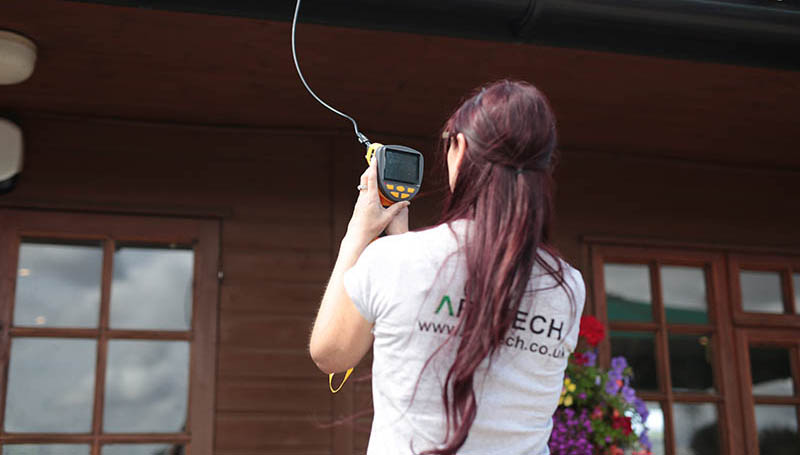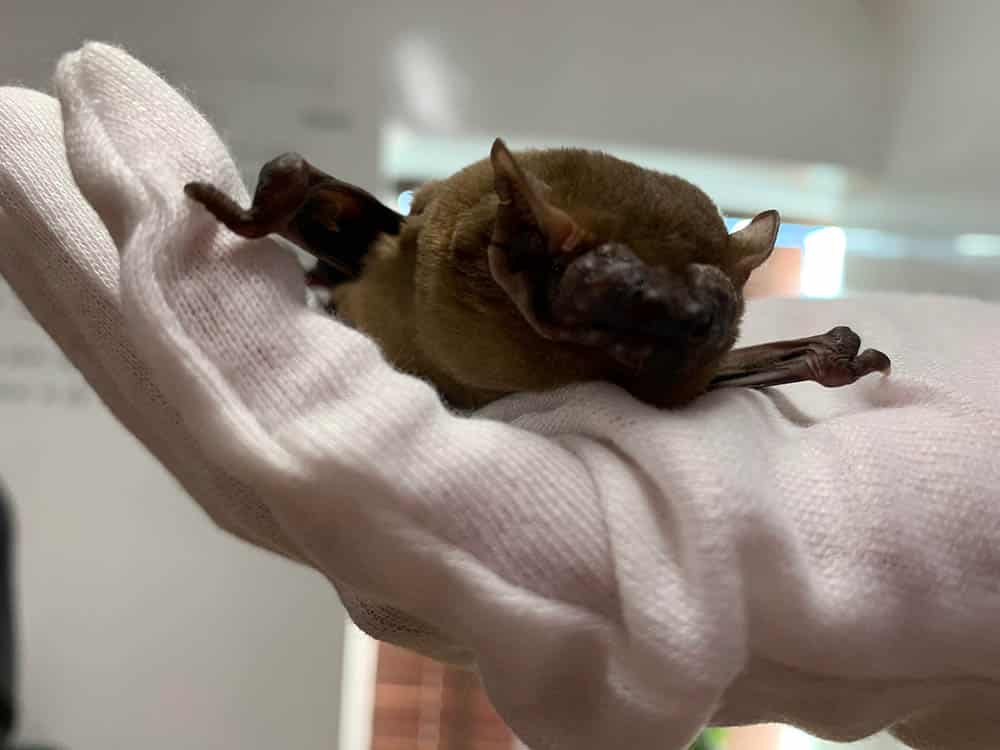Everything Developers Need to Know About Bat Surveys
What is a Bat Survey? On this page, you can find all the information you’re ever likely to need to know about bat surveys and what happens next. And if for some reason you don’t, our friendly bat consultants are available to answer your questions. A great place to start learning is the video below by Robert Oates, Managing Director of Arbtech.
Questions like ‘what happens to my planning application if I have bats?’ are asked of our team on a daily basis by people just like you, all across the UK.
We know bats weren’t in your game plan and the original costings for your project, so we do appreciate that you are a little worried about what comes next. Fortunately, our team have never failed to secure planning consent for a client where bats have been found or were suspected to be present on a site.
For new development proposals to fall in line with the local authorities and support roosting bats, you will need a full bat survey, the corresponding report to be submitted to your local planning authority, and in rare cases, protected species licences to be obtained. But for the experienced ecologists at Arbtech, it’s all in a day’s work.
With a huge team of fully licensed ecologists all over the country, we have among the broadest and deepest bat expertise of any ecological consultancy in the UK. If you’re submitting a planning application in 2023, then this page features everything you need to know.
First, some background – what is it that defines a bat roost?
In the UK, we have 17 different bat species that breed here and they are all protected by law. Bats live in places referred to as roosts. When we talk about a roost, we are referring to the feeding or resting place of a bat.
A bat roost can be found in a number of different places. Bats roost in caves, cracks in trees, lofts and buildings close to the natural environment, rural communities and woodlands such as agricultural buildings, livestock buildings and barns. Potential roosting features can even include within a loft space, or under weatherboarding, roof voids and loose, hanging tiles such as the roof tiles on slate roofs on the exterior of properties. Generally speaking, bats find roosting opportunities where there is a safe place to hibernate, raise their babies and find foraging areas for insects and water to feed on.
The type of bat – crevice or void dwelling – will generally dictate the roost type. For example, depending on the type of bat, the suitable roost could be on the interior or exterior of a tree or an existing building. Bats also have different requirements for their roosts at different times of the year, so they will often move around to find new roosts that suit them and occupy multiple sites throughout the year.
Roost types include day roosts, feeding roosts, maternity roosts, transitionary roosts or roosts that are chosen as suitable foraging habitats, breeding sites and resting places, and many more. Each of these bat roosts will be spatially different and provide the bats with natural habitats that offer security from predators while being relatively stable in terms of their exposure to changes in temperature, humidity, wind, noise and light.
What is the Bat Survey Process?
There are two types of bat surveys – a Scoping Bat Survey (stage 1) and a Bat Emergence and Re-Entry Survey (stage 2). Below, we explain the difference between the two bat surveys and the order in which they are carried out:
Stage 1 Survey
Also known as a Preliminary Roost Assessment (PRA), a Scoping Survey is an internal and external inspection of your building and can be undertaken at any time of the year. The exercise is designed to report to you and exclude the presence of three triggers for Emergence and Re-Entry Surveys, as follows:
- Presence of bats i.e. positive/negative
- Evidence of their activity e.g. droppings, urine stains, feeding remains of prey, dead bat carcasses and other evidence that could indicate a reasonable likelihood of bat species present
- Access to features suitable for roosting; graded on a continuum from negligible through to high
An inexpensive and quick survey, Preliminary Roost Assessments will see an ecologist determine whether bats are present on the site, or even if there is potential for the site to house bats or the proposed project to impact bats. Over the course of a site visit, the ecology consultant will look over important areas where bats may be present in the first instance.
The survey work will either confirm that bats are present and further surveys are needed, or that bats aren’t present and the planning process can continue with assurances from the ecologist that it is safe to progress into future stages.
Stage 2 Survey
Once a professional ecologist has undertaken a PRA and identified a bat found on the development site or evidence of bats present, it may be applicable for a Bat Emergence Survey. Also known as Bat Emergence and Re-Entry Surveys (BERS) or Bat Activity Surveys, an Emergence Survey is a more detailed assessment that will enable a secondary inspection to record bats on the site and determine access points and exit points, bat species, bat populations and flight paths, all over multiple visits across two or three surveys.
The bat surveyors use specialist bat detectors that record and convert bat echolocation calls into sounds we can hear and interpret. When bats are present on a site, activity surveys are conducted either as the sun rises or sets as it is when they can be seen to emerge or re-enter a roost. Additionally, in some instances, the ecological surveyor may also integrate radio tagging and DNA analysis into the assessment.
In the UK, bats hibernate during the winter months, when the insects they predate upon are less abundant. This means that these types of surveys are limited to the bat survey season across summer months, typically though not exclusively ranging from May to September inclusive. Even in bat survey season, a factor that can harm bats, their behaviour and the assessment process is the weather, especially in the case of heavy rain and high winds.
When can bat surveys be done?
If individual bats are present, evidence of bats is found or there is medium to high potential for roosting – such as hanging tiles, gaps in walls, unsealed properties or infrastructure close to woodland – you will have to propose mitigation measures or habitat enhancements for bats in your planning application.
Without this mitigation, your project may affect bats present on the site and there would be a net loss of habitat – the cause of bat population decline that drove lawmakers to legally protect bats and their roosts in the first place. Mitigation work could range from simple changes such as installing bat boxes for crevice dwelling bats, to more significant changes such as relocating bats to other areas inside or outside of the site.
Obviously, it is not possible in most cases to propose bat mitigation for habitat loss if, for example, the species of bat, the population numbers, and the roost’s significance is unknown. To illustrate this point: it is much easier to mitigate for a single pipistrelle male – common throughout the UK – using your site as an occasional summer roost than, say, a large maternity colony of a rarer species of bat.
What does a bat survey cost in 2023?
Typically, Preliminary Roost Assessment prices start from £299+VAT, as they represent around a day’s work. Emergence and Re-Entry Surveys involve several visits to the site, at night, normally by at least two surveyors to ensure that all angles of the building are covered.
This means that costs for the Emergence Survey are more expensive, typically costing in excess of £789+VAT as they represent around two to three day’s work.
Looking for a competitive quote? We all want the best price possible for the services we get, and not only are our costs very low, but we have 18 years of experience doing this. If you use Arbtech, you’ll be guided through the PRA process by the best in the business while getting amazing value for money too.
Bat Surveys and the Law – How are Bats Protected?
All species of bat native to the UK are legally protected through their inclusion in habitats regulations, namely Schedule II of the Conservation of Habitats and Species Regulations 2017 and Section 9 of the Wildlife and Countryside Act 1981.
Harming and/or disturbing bats and their roosts is a criminally prosecutable offence. For example, in 2020, a London division of Bellway Homes was fined £600,000 (plus court fees, the prosecution’s costs, and an award to the Bat Conservation Trust (BCT)) for the destruction of a bat roost without the appropriate licence in place.
Bat surveys and licensing are hardly what you might call ‘cheap’, but a belt and braces approach might have cost a tiny fraction of that overall cost, not to mention the criminal record for the company executive held responsible; maybe 1/100th of the fine, or something close to that figure. There is a considerable volume of additional, well-established case law supporting prosecutions for development disturbing bats, which twice has reached the Supreme Courts.
The take home point is that if you’re planning to impact upon buildings, trees and/or other potential roosting sites in the course of your development, however insignificant the impact may seem, you have a legal obligation to avoid disturbing bats as you do so.
For more information on bat protection and licencing rules in England and Wales, as well as in Scotland and Northern Ireland, the government offers insight from the Department for Environment, Food and Rural Affairs (DEFRA):
Natural England and DEFRA Bat Protection and Licences
Our Expert’s Legislation Summary for UK species
Current bat protection laws make it illegal to:
- Deliberately kill, injure or capture bats
- Damage, destroy or obstruct access to bat roosts
- Disturb bats, whether at roost or not
- Possess or transport a bat or any part of a bat, unless acquired legally
- Sell, barter or exchange bats, or any part of a bat
European Protected Species Licence Applications: how they affect your scheme and schedule
On some occasions, if you have a bat survey done which shows bats species present and you may need to destroy a bat roost as part of your development proposal, you will require a European protected species licence (EPSL) from Natural England.
The EPSL process is a separate process that can take up to six weeks. We can help with this process and have an outstanding record of getting applications for European protected species licences approved.
Where a bat roost of low conservation value is present (i.e. small numbers of common bat species), a new type of licence is available (in England only). This is called a Low Impact Class Licence, a Bat Mitigation Class Licence or simply a Low Impact Bat Licence.
This licence can be applied in a much shorter time frame than a full EPSL, thereby preventing any delays to your development. Arbtech is able to offer licence applications to our clients for this type of licence thanks to our highly experienced consultants.
The Bat Survey Guidelines and what they mean for you
By arranging a full bat survey for work that involves the conversion, modification or removal of an existing building, our team can find bats or evidence of the presence of bats on your site. We can then provide further advice to you, helping you to sufficiently support bats in the eyes of relevant legislation.
In this way, our activity surveys, the corresponding bat survey report and the survey data from the assessment can show scientifically that the mitigation work you propose as part of your planning application is adequate and appropriate to the species and population of bat, and the actual use of the site.

The BCT’s updated guidelines for professional ecologists are expected to increase the demand for activity surveys in an effort to demonstrate probable absence in the case of more esoteric species, as well as those more common but difficult to spot, such as common pipistrelle that roost in very small crevices.
This is in response to an updated scientific study that relates to the confidence with which surveyors can identify crevice dwelling species and their roosts from a preliminary assessment.
The Inspection and Reporting Process
Your full planning application, supported by a stage 1 and/or stage 2 bat survey report, will enable you to secure planning consent.
Under certain circumstances, you may require an EPSL for your proposed development, but that will not affect planning applications.
In summary:
- Get a preliminary assessment done.
- If you need to, get the Bat Emergence and Re-Entry Surveys done.
- Propose appropriate mitigation for bats in your application.
- Get your planning permission.
- Apply for an EPSL if applicable.
How do you choose a bat surveyor for your project?
Bat surveys must only be performed by a licensed bat consultant – someone who is educated and trained to handle and disturb bats safely and has proven this to the powers that be. A bat mitigation licence is issued to an ecologist by Natural England in England and Natural Resources Wales in Wales.
These two bodies are known as Statutory Nature Conservation Organisations. The licence essentially permits actions that would otherwise be unlawful e.g. efforts to disrupt bats or obstruct access to roosts – which you frequently do when visiting their habitats.

Without a bat licence, a surveyor must retreat if they discover evidence of a bat roosting, which is not much use to you, as the resulting report would be incomplete.
Furthermore, without a licence, the surveyor may be judged to be incompetent and see their report disregarded by the local planning authority.
Ask to see proof of your licensed bat consultant’s ecological qualifications, training and most importantly, a science and conservation licence (class 1 or better) for bats, issued by an SNCO.
Professional Indemnity insurance of £1m wouldn’t be a bad thing, either.
How are we different?
Unlike other ecologists, we only undertake planning and development-related work, so our bat experts’ skills are not diluted over a multitude of disciplines and sectors. Using this approach, we remain focused on the task at hand and provide advice under our own best practice guidelines, detailed guidance based on applicable UK and European legislation, and the necessary mitigation and compensation measures.
All of our staff are also experienced, qualified, aware of the planning requirements based on the local authorities in the areas they cover and, in the case of our large network of ecologists, licenced correctly by corresponding regulators.
We care the most about what matters to you: getting planning permission via the path of least resistance.
Still have questions about our bat surveys? Our FAQs section below will answer the most common questions we get…
Arbtech Reviews – Hundreds of Them
We have hundreds of genuine 5-star reviews on our website, reviews.co.uk and Trust Pilot. Based on feedback from past and present clients, you can be absolutely sure your project is in good hands.


